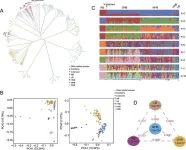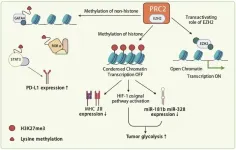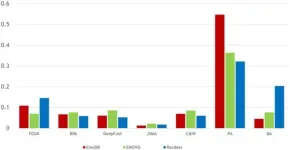(Press-News.org) New research shows how the chief resident position in academic internal medicine residency programs has evolved over the past 20 years, revealing how the position has changed, the types of careers these individuals pursue, and improvement in gender representation.
These findings, published this summer by the American Journal of Medicine, stem from a 20-year multicenter study that involved the University of Colorado Internal Medicine Residency Program. CU Department of Medicine faculty member William Turbyfill, MD, was among the study’s site investigators.
Turbyfill, who practices in the Veterans Affairs Eastern Colorado Health Care System, is part of a collective of hospitalists who are interested in research throughout the VA. He says the lead author of the study, Tyler J. Albert, MD, recognized there was a lack of research on chief residents despite their important role in medical education.
“We realized this is something no one has really looked at before, prompting us to wonder — how do we catalog this, and from that, what are the trends we see? What has happened in the past, and what might be happening in the future?” says Turbyfill, an assistant professor in the Division of Hospital Medicine.
Site investigators from 22 academically-affiliated internal medicine residency programs across the U.S. were recruited using the VA Academic Hospitalist Work Group. These investigators created a comprehensive registry of chief residents who served at their residency program between the academic years of 2001-2002 and 2020-2021, resulting in a final cohort of 2,060 chief residents.
“Ultimately, our goal was to understand how we can position chief residency throughout academic medicine in the U.S. to both support those who are chief residents and support the greater mission of providing excellent medical care in all of these institutions,” he says.
How the role — and population — has evolved
The chief resident position can vary depending on the residency program, but it typically is an additional year of training that involves more independence and responsibility.
“As a chief resident, you are uniquely positioned in that you serve as a bridge between residents and supervisors,” says Turbyfill, who previously served as a chief resident for the CU Internal Medicine Residency Program. “In some ways, you become the face of the residency program. You help manage the day-to-day operations, scheduling conflicts, and recruitment for residents coming into the program. You gain a lot of experience and have opportunities for teaching, as well.”
Over the years, more role-specific positions have formed, such as quality improvement and patient safety chief residents.
“Particularly at the VA, there has been a trend recently to have quality and safety chief residents,” Turbyfill says. “Their goal is to focus more on projects to improve the quality and safety of the hospitals, residency programs, and hospital systems they work in.”
The study revealed a strong association between the size of the residency program and the number of different chief resident roles offered, with smaller programs having more general chief residents and larger programs having more inpatient and ambulatory chief resident positions.
The study also found that there are more internal medicine chief residents now than there were two decades ago. The annual number of chief residents increased by 38% over the 20-year period across the 22 internal medicine residency programs. Per program, the median number of chief residents increased from three to five.
There was also significant improvement in gender parity among the internal medicine chief residents over time. Overall, 46% of the chief residents in the cohort were female, and the data showed clear improvement in gender representation throughout the 20 years. For the academic year 2001-2002, 39% of the chief residents were female, whereas for the 2020-2021 academic year, 52% were female.
Where the chief residents go
Beyond studying how the chief resident position and population has evolved, Turbyfill and his colleagues also aimed to find out more about their future career paths.
They found that roughly 63% of the chief residents pursued subspecialty training after chief residency. The most prevalent subspecialties were cardiology, pulmonary and critical care medicine, gastroenterology, and hematology and oncology.
“That was less surprising than the growth aspect, because chief residency has often been considered a stepping stone for going into subspecialties,” Turbyfill says. “But over the years, we also saw there was a higher increase of people entering into hospital medicine, like I did.”
According to the study, 36% of chief residents pursued careers in internal medicine, with 18% pursuing primary care and 17% pursuing hospital medicine. Over the 20-year period, an increasing proportion of chief residents pursued careers in hospital medicine.
“The hospitalist cohort has grown in medicine in general. I think this growth reflects that chief residency provides a great starting point for future hospitalists,” Turbyfill says. “To me, it’s exciting to see that chief residency may be moving in a direction where it’s potentially less of a stepping stone into a subspecialty and more people are interested in hospital medicine.”
Overall, 56% of chief residents remained in academic medicine — with many remaining at the institution they trained at — and the proportion increased over time. The study authors say this indicates chief residency is a “pipeline for future academicians.”
Unanswered questions
Although this study was able to shed light on the past and present status of internal medicine chief residency, Turbyfill says the next step is to find out why certain trends exist. For instance, why has the number of chief residents increased? Why do most of them remain in academic medicine? And why have more chief residents become interested in hospital medicine over the past 20 years?
“The whole point of this research is that it shows us the state of things right now and what has changed over the years,” he says. “From this, we can conduct more studies to answer those ‘why’ questions.”
One of the most interesting trends Turbyfill saw was the improvement in gender representation among the chief residents, especially considering there are still significant gender disparities in residency and fellowship programs, as well as across academic medicine in general.
“Now that we have that data, I think we're all interested in finding out what barriers exist so we can hopefully move more toward gender parity in the future,” Turbyfill says.
“That’s why this study is important — it sparked a lot of interest and curiosity,” he adds. “It gives us a baseline to build off of so we can improve how we train the next generation of doctors and leaders in the academic realm.”
END
National study shows how internal medicine chief residency has changed over 20 years
CU physician William Turbyfill, MD, contributed to a national study that found better gender representation and new career trends — among other changes — in internal medicine chief residents from 2001 to 2021
2024-08-09
ELSE PRESS RELEASES FROM THIS DATE:
VA’s Disrupted Care National Project discovers vascular surgery rates still decreasing since COVID-19 pandemic
2024-08-09
White River Junction, VT – Recently published findings from the VA Disrupted Care National Project (DCNP) revealed the number of vascular surgeries performed across the United States continued to decline even after large drops during the COVID-19 pandemic.
A multi-institutional team of researchers, led by the White River Junction VA Medical Center, analyzed 21,031 vascular surgeries of three common procedures from 2019 to 2023 using Medicare claim data. There was a dramatic drop of 47% at the beginning of the pandemic, but while rates of care recovered partially another ...
Looking to boost your heart health? Try a baked potato
2024-08-09
The potato is small enough to fit inside a person’s hand yet contains enough nutrients to whittle waistlines and lower blood sugar in adults with Type 2 diabetes. Yet, despite the fact that potatoes – particularly the skins – are packed with health-boosting nutrients, they routinely get a bad rap among dieters.
That may soon change, thanks to new research by Neda Akhavan, assistant professor in the Department of Kinesiology and Nutrition Sciences within UNLV’s School of Integrated Health ...
Experts provide further proof of role testosterone plays in preventing severe Covid
2024-08-09
A new study has revealed important information about how a patient’s testosterone level can help protect them from severe Covid-19.
Previous research involving Swansea University investigated how sex hormones are likely to be important determinants of Covid-19 severity.
Now digit ratio expert Professor John Manning, of the Applied Sports, Technology, Exercise and Medicine (A-STEM) research team, has been working with colleagues in Poland and Sweden to look more closely at the subject.
He says their findings, which have just been published ...
Vegan diet better than Mediterranean diet for weight loss and reducing harmful inflammatory dietary compounds, finds new research
2024-08-09
WASHINGTON, D.C.—Eating a low-fat vegan diet reduces harmful inflammatory dietary compounds called advanced glycation end-products (AGEs) by 73%, compared to no reduction on a Mediterranean diet, according to new research by the Physicians Committee for Responsible Medicine published in Frontiers in Nutrition. The decrease in AGEs on the vegan diet was associated with an average weight loss of 13 pounds, compared with no change on the Mediterranean diet.
The reduction of dietary AGEs on the low-fat vegan diet came mainly from excluding the consumption ...
'PTNM' System provides new classification for Peyronie's disease and penile curvature
2024-08-09
August 9, 2024 — Analysis of men seen at a specialist clinic provides new insights into the classification of Peyronie's disease (PD) subtypes, according to a report in the September issue of The Journal of Urology®, an Official Journal of the American Urological Association (AUA). The journal is published in the Lippincott portfolio by Wolters Kluwer.
"By analyzing real-world clinical data in a large group of patients, we identified four distinct subtypes of PD, and additional categorization of other causes of penile curvature," comments Landon Trost, MD, of Male Fertility and Peyronie's ...
The molecular shield: how tea plants combat drought through protein phosphorylation
2024-08-09
A pivotal study has discovered a protein phosphorylation mechanism that plays a critical role in the negative regulation of flavonoid biosynthesis in tea plants (Camellia sinensis) during drought stress. This insight into the molecular response of tea plants to environmental stress could lead to the development of agricultural strategies to enhance crop resilience and quality preservation under water scarcity conditions.
Drought stress poses a significant challenge to agriculture, causing substantial yield losses in many crops. Tea plants, known for their rich flavonoid content ...
Spectral measurements capable of estimating nutrient content of forest tree leaves
2024-08-09
The general health of forests can be estimated by the micro- and macronutrient content of tree leaves to help inform forest management decisions in the light of climate change, species loss and other variables. Traditional methods of assessing nutrient levels in forests are expensive and labor-intensive. Researchers recently analyzed the reflected spectra from tree foliage to accurately estimate the nutrients of leaves, offering a faster, larger-scale method of assessing forest health.
Field methods of collecting leaf samples ...
Blueprint for blueberry improvement: genetic and epigenetic discoveries
2024-08-09
Recent research has uncovered significant genetic and epigenetic variations in blueberry cultivars, particularly between northern highbush (NHB) and southern highbush (SHB) blueberries. The study highlights gene introgression's role in SHB's adaptation to subtropical climates and identifies key genes, such as VcTBL44, associated with fruit firmness. These findings offer valuable insights and resources for future blueberry breeding.
Blueberries, part of the Vaccinium genus, are renowned for their nutritional benefits and increasing global demand. However, cultivation faces challenges like ...
The heightened importance of EZH2 in cancer immunotherapy
2024-08-09
Enhancer of zeste homolog 2 (EZH2) is a catalytic subunit of the Polycomb-repressive complex 2 (PRC2), which plays a crucial role in transcriptional repression through the methylation of histone H3 on lysine 27 (H3K27me3). This epigenetic modification leads to chromatin compaction and gene silencing. EZH2 is frequently overexpressed in a variety of cancers, including head and neck, breast, prostate, bladder, colorectal, lung, pancreatic, melanoma, and lymphoma. Mutations in the EZH2 gene are also prevalent in several hematological malignancies, such as B-lymphomas and follicular lymphomas. The dual role of EZH2 as both a tumor suppressor and oncogene depending on the cancer type ...
Researchers expose vulnerability of speech emotion recognition models to adversarial attacks
2024-08-09
Recent advancements in speech emotion recognition have highlighted the significant potential of deep learning technologies across various applications. However, these deep learning models are susceptible to adversarial attacks. A team of researchers at the University of Milan systematically evaluated the impact of white-box and black-box attacks on different languages and genders within speech emotion recognition. The research was published May 27 in Intelligent Computing, a Science Partner Journal.
The ...
LAST 30 PRESS RELEASES:
Making lighter work of calculating fluid and heat flow
Normalizing blood sugar can halve heart attack risk
Lowering blood sugar cuts heart attack risk in people with prediabetes
Study links genetic variants to risk of blinding eye disease in premature infants
Non-opioid ‘pain sponge’ therapy halts cartilage degeneration and relieves chronic pain
AI can pick up cultural values by mimicking how kids learn
China’s ecological redlines offer fast track to 30 x 30 global conservation goal
Invisible indoor threats: emerging household contaminants and their growing risks to human health
Adding antibody treatment to chemo boosts outcomes for children with rare cancer
Germline pathogenic variants among women without a history of breast cancer
Tanning beds triple melanoma risk, potentially causing broad DNA damage
Unique bond identified as key to viral infection speed
Indoor tanning makes youthful skin much older on a genetic level
Mouse model sheds new light on the causes and potential solutions to human GI problems linked to muscular dystrophy
The Journal of Nuclear Medicine ahead-of-print tip sheet: December 12, 2025
Smarter tools for peering into the microscopic world
Applications open for funding to conduct research in the Kinsey Institute archives
Global measure underestimates the severity of food insecurity
Child survivors of critical illness are missing out on timely follow up care
Risk-based vs annual breast cancer screening / the WISDOM randomized clinical trial
University of Toronto launches Electric Vehicle Innovation Ontario to accelerate advanced EV technologies and build Canada’s innovation advantage
Early relapse predicts poor outcomes in aggressive blood cancer
American College of Lifestyle Medicine applauds two CMS models aligned with lifestyle medicine practice and reimbursement
Clinical trial finds cannabis use not a barrier to quitting nicotine vaping
Supplemental nutrition assistance program policies and food insecurity
Switching immune cells to “night mode” could limit damage after a heart attack, study suggests
URI-based Global RIghts Project report spotlights continued troubling trends in worldwide inhumane treatment
Neutrophils are less aggressive at night, explaining why nighttime heart attacks cause less damage than daytime events
Menopausal hormone therapy may not pose breast cancer risk for women with BRCA mutations
Mobile health tool may improve quality of life for adolescent and young adult breast cancer survivors
[Press-News.org] National study shows how internal medicine chief residency has changed over 20 yearsCU physician William Turbyfill, MD, contributed to a national study that found better gender representation and new career trends — among other changes — in internal medicine chief residents from 2001 to 2021




